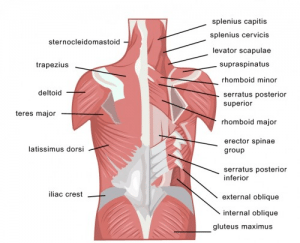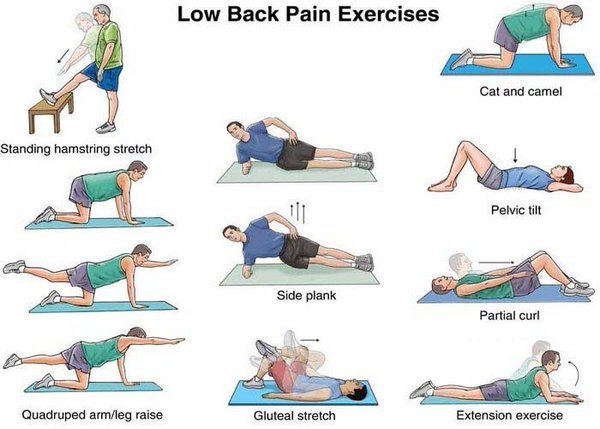Lower back pain s without doubt one of the most common conditions which we treat here at complete chiropractic. Its not surprising, because studies show that the number of people reporting lower back problems has increased dramatically over the past few decades. In fact, four out of five adults will now experience LBP at some point in their lives.
As an adjunct to chiropractic care, we recommend specific exercise regimes target to reduce pain – but what exercises are best? Read on to find out!
LBP Basics
Lower back pain is typically classified as chronic or acute. While acute pain generally lasts a few days or weeks, chronic pain persists for months or longer. Chronic back pain can be progressive , or occasionally flare up and subside.
The chiropractic approach is highly effective for patients with both acute and chronic LBP. – especially when combined with exercise and stretching. The chiropractic protocol involves searching the spine for the presence of a condition known as vertebral subluxation – This common malady is characterized by areas in the spine where movement is restricted or bones (vertebrae) are slightly out of alignment. Chiropractic treatment aims to correct the subluxations using gentle adjustments, which over time can substantially decrease or eliminate lower back pain.
Lower back pain, like most pain is really just is the body ‘s way of indicating that something’s amiss. This is why we can say that generally, painkillers are not the best approach to back pain, since masking this critical warning with drugs does not address the underlying issue. Many painkillers also have unpleasant or dangerous side effects, whereas the chiropractic approach is all natural and totally drug free.
The low back pain beating workout
A daily, 30-minute walk is an excellent way to get started – is not just an easy way to stay active and burn calories, its also a great tool for maintaining flexibility in the lower back. Even better is a comprehensive workout designed to support the lower back.
As part of a recent experiment, researchers divided 71 LBP sufferers (36 men and 35 women) into two workout groups. Participants either walked each day or engaged in a graded workout, emphasising lower back stability exercises. After 12 months, researchers assessed the participants ‘ levels of pain and disability, physical health , fear-avoidance of exercise and self-reliance.
The study showed that at 12 months, group comparison showed a reduction in perceived disability in favor of the targeted exercise group,. Ratings of physical health and self-efficacy beliefs also improved in the exercise group over the long term, though no changes were observed for fear-avoidance beliefs.
What the study tells us, is that targeted exercises (of the kind we can give you here at complete chiropractic!) can have a significant impact – however exercise alone will not totally resolve the situation. Many patients do still have aspects of life they try to avoid in the hopes of preventing pain. This is where chiropractic treatment can really shine, since our approach is to eliminate the underlying cause of the condition – thereby effective preventing future injury.
Resistance Training
Some research shows that adding resistance training to your workout regimen wards off LBP. What exactly is “resistance training”? Simply put, it’s any exercise where muscles contract against an external resistance. It can be accomplished with weights, rubber exercise tubing, your own body weight, water bottles, etc. Resistance training amplifies strength, tone, mass and endurance.
As part of a recent analysis, researchers compared resistance training to standard aerobic exercise for musculoskeletal health, body composition , pain, disability and quality of life in patients with chronic low-back pain (CLBP). Researchers divided 27 LBP study volunteers equally into three groups: ( I ) resistance training, (2) aerobic exercise or (3) a no exercise control group. During the 16- week study participants increased the intensity and amount of exercise.
Researchers measured each group’s progress after eight weeks and again at 16 weeks. The resistance training exercisers “significantly improved” their musculoskeletal fitness, pain, disability level and quality of life (QOL). Conversely, the aerobic exercise group “showed no significant improvements in pain, disability, or QOL.” However, aerobic exercisers exhibited more “significant improvements” in flexibility, cardio vascular stamina and leg power than the resistance group.
Overall the study therefore suggests that a mix of resistance and cardiovascular training is likely to be effective in warding off LBP, but that resistance training probably makes the biggest contribution to pain reduction.[1] If you need some advice in introducing some appropriate resistance exercise, just ask your chiropractor!
Core Strengthening helps
Strengthening core muscles prevents LBP by supporting the spine and strengthening the muscles directly responsible for lower back stability.
One large-scale analysis measured core muscle power in 1,527 LBP sufferers (739 men and 788 women) in their seventies. Participants reporting higher LBP severity during the previous year had less muscle strength in three key core muscle groups: lateral abdominals, lumbar paraspinals and rectus abdominis. The link between poor core strength and lower back pain is therefore easy to see! [2]
Core strengthening exercises are simple to do and can be done in the comfort of your own home, at work, or at school or university. We provide our clients with some gentle core strengthens in the majority of cases.
Resting might not help…
Directly strengthening the abdominal muscles, and the muscles of the lower back allow them to take more of the load of everyday life, thereby reducing the load placed on the spine itself. Research shows that core exercises lessen stress on the spine more than merely resting does. This means that the traditional approach of resting the back is likely to be ineffective in reducing lower back pain in many cases.
ln one experiment, participants first performed press ups to simulate “loading” the spine. Next, the individuals either rested or performed abdominal exercises, while the researchers measured spinal loading. The result? The abdominal exercises produced greater recovery[3].
Aquatic Exercise

Female swimmers doing exercises with training equipment in swimming pool
Throughout this blog we’ve talked about many different forms of exercise, but for some LBP patients any of the above may simply seem too painful. Even patients with severe pain can experience a reduction in pain as a result of chiropractic care, but how can you support this treatment if traditional exercise seems too much?
Thankfully, new research – performed in Finland – shows that swimming and other types of aquatic exercise are hugely beneficial for LBP.
After reviewing 17 years of research data, investigators selected seven clinical trials. Each study focused on LBP patients who used water work outs to combat pain and disability. To assess LBP severity, the studies looked at disability assessments, pain questionnaires, pain rating scales and the number of work days lost due to LBP – exactly the same measures we use in our clinic.
The conclusion was that there was sufficient evidence to suggest that therapeutic aquatic exercise is potentially beneficial to patients suffering from chronic low back pain and pregnancy-related low back pain. [4] While further research is needed to determine the best approach, for now we can say that aquatic exercise can be a great low-pain choice for LBP sufferers.
We can help
This blog is intended as a quick overview of the latest thinking on exercise for LBP. Because everyone’s pain is different, and indeed, the cause of that pain is often different its important that you get your situation assessed by our chiropractic team, who will be able to pinpoint tour issue and recommend exercises which are specifically targeted for your needs. It’s all included in the treatment price at complete chiropractic, so why not make an appointment today!
[1] J Strength Cond Res 20p9 Epub.
[2] J Geronto/ A Biol Sci Med Sci 2005 ;60:882-7
[3] C/in Bio mech 2007;22:972
[4] Clin Rehabil 2009;23 :3-14.)


